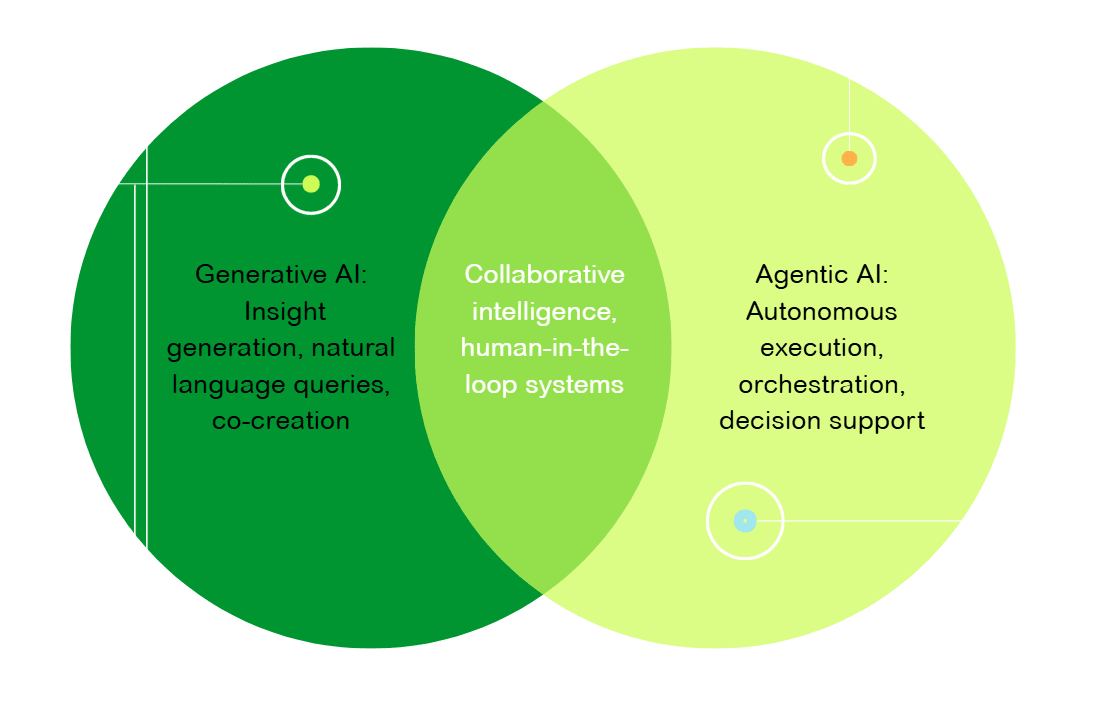AI at the Speed of Climate: Why Generative and Agentic Intelligence Are Both Essential for Resilience

As climate change accelerates, so must our response. The climate crisis is the defining challenge of our time. As global temperatures rise, ecosystems destabilize, and resource scarcity intensifies, the need for transformative solutions has never been more urgent. Enterprises are facing unprecedented pressure to reduce emissions, adapt to regulatory shifts, and build resilience into their operations.
At Schneider Electric, we believe that addressing today’s climate challenges demands using AI in innovative ways. Our approach is to combine the creative power of generative AI with the autonomous capabilities of agentic AI to unlock transformational solutions, because technology alone isn’t enough.
This is a pivotal moment, one that calls for collective action and bold leadership to keep up with the accelerating pace of innovation and climate risk. The path forward lies in collaborative intelligence: the fusion of cutting-edge technology paired with human insight and expertise, to make a measurable impact and secure a livable future for generations to come.
The Climate Imperative: Speed, Scale, and Intelligence
Climate risk has shifted from a hypothetical concern to a core operational priority. From extreme weather events to supply chain disruptions, sustainability leaders are navigating a landscape that demands faster decisions and scalable solutions. Traditional tools, spreadsheets, dashboards, and manual reporting can’t keep up. Artificial intelligence is both the solution and the challenge. Integrating AI responsibly requires human oversight and input. Pairing human judgment with the computational power of AI ensures transparency and validation of data and processes. [World Economic Report: AI for Sustainability, 2025]
For two decades, Schneider Electric’s EcoStruxture™ Resource Advisor software solution has been the trusted platform helping global organizations navigate and manage the early stages of their sustainability journey. Today, with more than 2,000 companies being served, we bring forward lessons learned and tackle new challenges to help our clients achieve their sustainability and energy goals. That’s why we began embedding AI directly into the core of our sustainability ecosystem. Our Resource Advisor Copilot, powered by generative AI, was a foundational leap forward. It enabled users to interact with complex datasets using natural language, instantly generating insights.
“Resource Advisor Copilot was initially designed to guide users through Resource Advisor tools and reports. The next evolution of Resource Advisor Copilot added analytical capabilities, allowing users to query emissions, energy usage, and cost data directly. But as expectations evolved, so did our vision,” Lauren Morris, Schneider Electric Software Product Manager, explains.
Carlos Ribadeneira Espinoza, Data Science Manager, Schneider Electric, adds:
“Resource Advisor Copilot helped bridge the gap between having data and turning it into actionable intelligence. But today’s climate risk demands real-time, holistic analysis, not just historical reporting.”
From Insight to Action: The Rise of Agentic AI

Insight alone isn’t enough. That’s where agentic AI comes in.
Agentic AI refers to intelligent systems that act autonomously based on data inputs, goals, and environmental feedback. These agents that once only analyzed data are now executing critical action points.
Dusty Wheatley, Manager, Data Science at Schneider Electric, shares a powerful example:
“Our Emissions Measurement Data Transformation Agent transforms messy, unstructured client data into a format usable by our carbon calculator, in seconds. What used to take hours or days is now done in minutes.”
Another innovation, the Emissions Factor Matching / Selection, uses AI to match activities with the correct emissions factors from tens of thousands of possibilities, dramatically improving speed and accuracy.
These capabilities are already being deployed to:
- Automate emissions tracking and reporting
- Optimize energy consumption across facilities
- Orchestrate decarbonization strategies across systems
Lauren Morris offers a helpful framework for understanding the diversity of agentic AI systems:
“The acronym TACO is an industry term commonly used to categorize the different types of AI agents:
- Taskers: execute simple tasks
- Automators: manage repetitive processes
- Collaborators: engage in brainstorming and co-creation with users
- Orchestrators: coordinate multiple agents and entire workflows
These capabilities are embedded in Schneider Electric’s AI-native ecosystem platform, which anticipates user needs and proactively surfaces relevant data.
Each plays a distinct role, from executing tasks to generating insights to coordinating complex workflows. It’s not a one-size-fits-all approach; it’s about working to assemble the right mix of capabilities to deliver smarter, more adaptive solutions.”
A Unified Hub for Climate Intelligence
 Recognizing the limitations of legacy sustainability tools in the market, Schneider Electric is now launching a suite of specialized software products built on a unified, next-generation platform that centralizes all energy and sustainability data. Purpose-built with agentic AI at its core, this platform powers a new portfolio of software solutions and capabilities designed to accelerate climate risk mitigation, starting with carbon accounting, supply chain engagement, and continuing with regulatory compliance and transparent reporting.
Recognizing the limitations of legacy sustainability tools in the market, Schneider Electric is now launching a suite of specialized software products built on a unified, next-generation platform that centralizes all energy and sustainability data. Purpose-built with agentic AI at its core, this platform powers a new portfolio of software solutions and capabilities designed to accelerate climate risk mitigation, starting with carbon accounting, supply chain engagement, and continuing with regulatory compliance and transparent reporting.
Lauren Morris describes it as:
“A workspace of action. With a new AI-driven orchestration agent, it doesn’t just visualize data; it connects, validates, and acts on it across the enterprise. The agent turns fragmented initiatives into coordinated, intelligent operations.”
“We’re building toward hyper-personalized agents that act as strategic advisors, analyzing footprints, energy contracts, and decarbonization pathways. It’s not just reporting, it’s scenario modeling, decision support, and autonomous execution,” Carlos Ribadeneira Espinoza adds.
This evolution marks a strategic shift, from reactive reporting to proactive, intelligent climate risk mitigation.
Enterprise ROI: AI as a Climate Multiplier
The business case for AI in climate resilience is no longer speculative; it’s measurable. According to Microsoft, enterprises leveraging AI for sustainability are seeing up to 8X return on investment in climate risk mitigation. From digital twins that simulate energy systems to generative models that accelerate materials discovery, AI is enabling companies to move from reactive compliance to proactive transformation. These tools don’t just reduce emissions; they unlock operational efficiency and resilience at scale. [Microsoft Cloud Blog, 2025]
Collaborative Intelligence: Humans + AI for Sustainability
Our approach isn’t about replacing human expertise; it's about elevating and amplifying its impact. Generative and agentic AI are designed to work alongside sustainability professionals. This is collaborative intelligence: AI handles the heavy lifting, while humans provide context, judgment, and ethical oversight.
Carlos Ribadeneira Espinoza emphasizes:
“We want agents that are smart, auditable, and trustworthy. To ensure efficiency, we optimize agents using frugal AI principles, minimizing unnecessary large language model (LLM) calls and focusing their efforts on the highest impact processes. This keeps performance lean, cost-effective, and aligned with user needs.”
This synergy is especially critical in sustainability and mitigating climate risk, where decisions often involve trade-offs, stakeholder engagement, and long-term vision.
Responsible Innovation: Frugal, Ethical AI
AI itself indeed has a carbon footprint. That’s why Schneider Electric is committed to frugal AI, designing systems that are efficient, scalable, and environmentally responsible.
In a recent analysis, Google Gemini, the company’s advanced AI platform, highlights the energy efficiency of AI compared to traditional human workflows. For example, a three-minute task performed by a human using a laptop and monitor consumes approximately 3.75 watt-hours (Wh) of electricity, while the same task executed by a large language model (LLM) in a data center may consume only about 1.4 Wh, less than half the energy. This efficiency becomes even more pronounced when scaled across thousands of repetitive tasks, such as emissions data extraction or ESG reporting.
The Venn diagram shows how Generative and Agentic AI combine to enable collaborative intelligence and human-in-the-loop systems.

However, the broader environmental impact of AI must account for the energy-intensive process of training these models. Like building a factory, training has a high upfront carbon cost, but once deployed, inference tasks are highly efficient. The sustainability value of AI is realized when that cost is spread across billions of low-energy tasks. Moreover, the carbon footprint of AI is deeply influenced by the energy source powering the data centers. Renewable-powered infrastructure, like that used by Google, dramatically reduces emissions compared to fossil-fueled grids.
This analysis reinforces Schneider Electric’s commitment to frugal AI, designing intelligent systems that minimize unnecessary LLM calls and focus on high-impact processes. By optimizing agentic AI for efficiency and aligning it with renewable energy sources, we ensure that the tools we deploy to fight climate change don’t inadvertently contribute to it.
Dusty Wheatley notes:
“Extracting ESG frameworks used to take thousands of hours. Our LLM-enabled tools now do it in under an hour, and our “question-and-answer” agents can answer hundreds of disclosure questions automatically, with source citations for confidence.”
Conclusion: A Dual Strategy for a Dual Crisis
Climate change is fast, complex, and unforgiving. It demands tools that can think and act, tools that combine the creativity of generative AI with the decisiveness of agentic AI.
Schneider Electric’s dual AI strategy is aligned with broader industry trends. According to Gartner, agentic AI is the top strategic technology trend for 2025, with predictions that 33% of enterprise software applications will include agentic AI by 2028, up from less than 1% in 2024.
However, Gartner also warns that over 40% of agentic AI projects may be canceled by 2027 due to unclear business value or poor risk controls.
This underscores the importance of Schneider Electric’s human-in-the-loop approach, which ensures transparency, oversight, and trust.
At Schneider Electric, we’re building that future today. From Resource Advisor to new intelligent software activated by AI-native technology, we’ve evolved from insight to measurable action, and from dashboards to autonomous intelligence.
Because when it comes to climate resilience, intelligence isn’t optional. It’s essential.
Want to learn more? Contact us today and let our global experts help guide you with strategy and technology that drives action and impact.